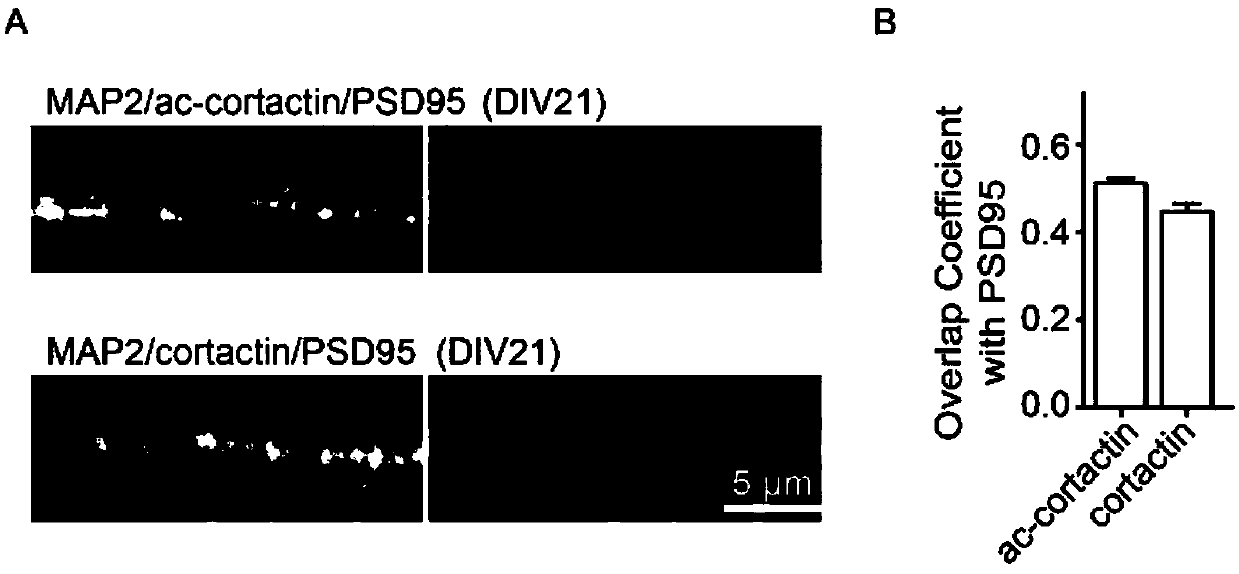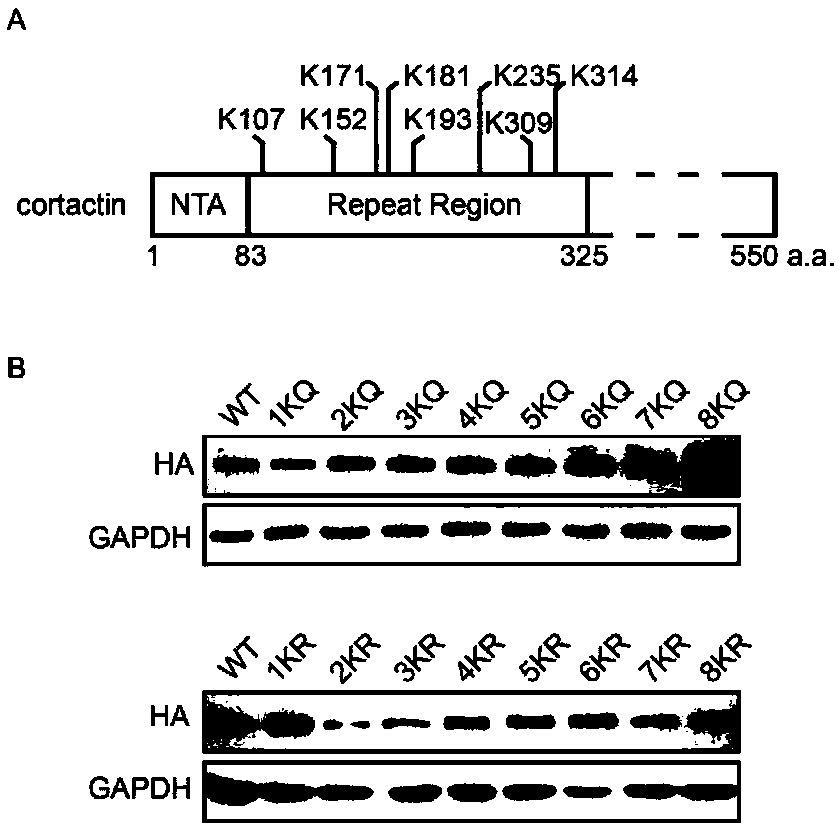Cortex actin mutant 8KQ and application
An actin and mutant technology, applied in the field of protein and peptides, can solve the problems of restricting the research on the pathogenesis of ASD and the development of clinical drugs, and achieve the effects of improving repetitive stereotyped behavior, improving synaptic morphology, and reducing binding capacity.
- Summary
- Abstract
- Description
- Claims
- Application Information
AI Technical Summary
Problems solved by technology
Method used
Image
Examples
Embodiment 1
[0037] Excitatory synapses express acetylated cortical actin
[0038] Coat petri dishes or slides with polylysine (PLL) in advance, and coat overnight at room temperature or coat at 37°C for 2 hours. Recover PLL, rinse with sterile water 3 times, and store the coated petri dish or glass slide at 4°C for 1 week. Pre-cool HBSS buffer, and pay attention to the operation before digestion to maintain low temperature and sterility. The suckling mouse was stunned on the day of birth, disinfected with 75% alcohol, and the brain was quickly taken. Strip the hippocampus / cortex tissue in HBSS and gently transfer to EP tube containing fresh HBSS. Cut into small pieces, digest with trypsin (0.125%) at 37°C for 30 min, during which the tissue pieces are gently resuspended every 10 min. The digestion was terminated with F12 medium containing 10% FBS, centrifuged at 800 rpm for 1 min, and the supernatant was removed. Add F12+10% FBS medium to resuspend, and let stand at 37°C for 5 min. Use ...
Embodiment 2
[0042] Studies have shown that the acetylation of cortical actin is regulated by acetyltransferase (PCAF) and deacetylase (HDAC6), and non-enzymatic acetylation may also exist. Acetyl-CoA (Ac-CoA) is the only source of acetyl groups required for protein acetylation. The concentration of Ac-CoA in the cell affects the level of acetylation modification of the protein. To explore this possibility and its biological significance, an in vitro acetylation experiment was carried out. Reaction buffer: Tris-HCl (50mM, pH8.0), EDTA (0.1mM), DTT (1mM), glycerol (10%), sodium butyrate (10mM), add protease inhibitor before use. Reaction substrate: cortical actin, acetyl donor Ac-CoA. The reaction system was incubated at 30°C for 1 hour, and the resulting reaction product was used for Western blot antibody detection. The antibody used was a pan-acetylated antibody acetylated-lysine; the amount of substrate cortical actin added was indicated by Coomassie brilliant blue staining. In the in v...
Embodiment 3
[0044] Identification of the acetylation site of cortical actin
[0045] In order to further explore the role of cortical actin acetylation in the regulation of postsynaptic structure and function, the LC-MS / MS method was used to identify in vitro acetylation experiments ( figure 2 ) The acetylation site of actin in the middle cortex. The SDS strips at the location of cortical actin stained with Coomassie brilliant blue were cut off, and the subsequent LC-MS / MS process was completed by Hangzhou Jingjie Biotechnology Co., Ltd. The specific process is as follows: the glue strip is cut into pieces, and the glue block is decolorized with 50% acetonitrile containing 50 mM ammonium bicarbonate (NH4HCO3). Incubate with 100% acetonitrile for 5 min to dehydrate the gel block, then remove the liquid phase from the system, add a dithiothreitol solution with a final concentration of 10 mM, and incubate at 37° C. for 60 min. Incubate with 100% acetonitrile again for dehydration, remove the ...
PUM
 Login to View More
Login to View More Abstract
Description
Claims
Application Information
 Login to View More
Login to View More - Generate Ideas
- Intellectual Property
- Life Sciences
- Materials
- Tech Scout
- Unparalleled Data Quality
- Higher Quality Content
- 60% Fewer Hallucinations
Browse by: Latest US Patents, China's latest patents, Technical Efficacy Thesaurus, Application Domain, Technology Topic, Popular Technical Reports.
© 2025 PatSnap. All rights reserved.Legal|Privacy policy|Modern Slavery Act Transparency Statement|Sitemap|About US| Contact US: help@patsnap.com



